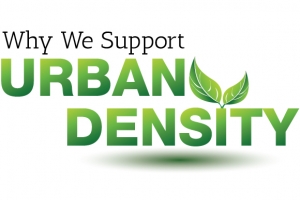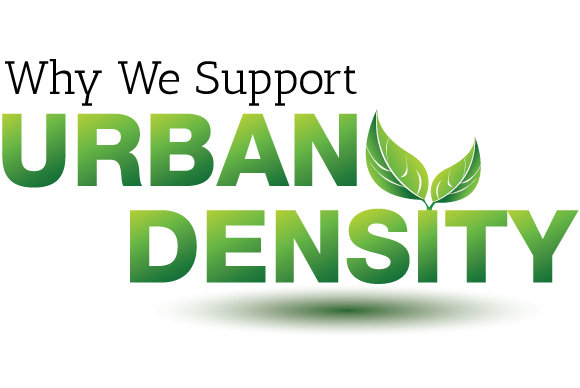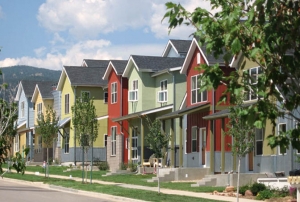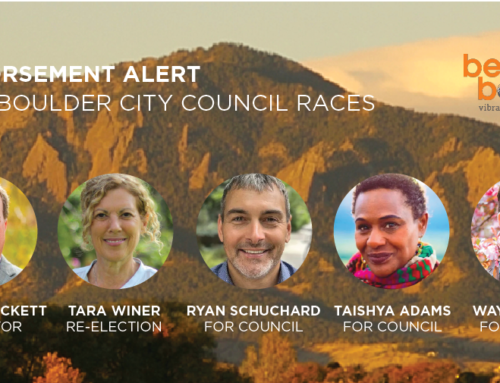 The three D’s of sustainable urban design are density, diversity, and design. All three are necessary o create vibrant, low carbon communities . The mechanisms by which appropriate density of activity within a city reduce per-capita CO2 emissions are manifold, including:
The three D’s of sustainable urban design are density, diversity, and design. All three are necessary o create vibrant, low carbon communities . The mechanisms by which appropriate density of activity within a city reduce per-capita CO2 emissions are manifold, including:
- Density provides the critical mass of users to allow efficient transit to be viable.
- When combined with a diversity of land use, density reduces average trip length and, correspondingly, transport-related CO2.
- When combined with good design, density makes walking more interesting, increasing pedestrian mode share. (People who think nothing of walking four blocks on the Pearl Street Mall will get in their cars to go the same distance on 28th St., because the low density makes walking so unappealing there.)
- Density leads to increased parking prices, which reduces driving.
- Density usually entails multi-story buildings and shared building envelopes, which reduce both embodied and operational energy.
- Denser development encourages smaller residential or commercial unit size, again reducing embodied and operational energy.
In practice, the results are clear. Denser cities like Boston, and San Francisco have much lower per-capita emissions than sprawling places like Atlanta, Houston, and Phoenix. Graphs showing the inverse relationship between density and transport-related emissions are particularly striking.
The general rule of thumb for the density necessary to support transit is 10-15 dwelling units/acre. In Boulder today, the minimum lot size in the RL-1 zone district — encompassing most of our single-family housing — is 7000 square feet, which yields 6 dwelling units/acre, even excluding land necessary for streets.
This can be achieved without excessive building height. Boulder’s Holiday neighborhood and the Prospect New Town development in Longmont are denser than most single-family areas of Boulder, while maintaining modest building heights and eminently walkable design. And many of the opportunities for denser development are in the large parking lots and 1960s style shopping and industrial areas in town.
Attaining a more sustainable level of density also need not entail significant changes to the character of existing residential neighborhoods, if it’s achieved by modifying zoning codes to allow smaller lot sizes, accessory dwelling units, row houses, or allowing more people to live together.
Why we support parking reform in Boulder
Nationally, the transportation sector accounted for 28% of greenhouse gas emissions in 2011, making it the second-largest culprit in the US contribution to climate change, a little behind electricity production. Boulder’s most recent greenhouse gas inventory showed transportation accounting for 22% of the city’s direct emissions, and most of that is due to private cars and trucks. This is a very conservative estimate, as it doesn’t take into consideration the carbon cost of thousands of heated garages, brightly-lit car lots, the embodied energy in our wide streets, and other ancillary costs that are a direct result of our auto-dependent lifestyles and urban design.
So what’s called for is a further shift from a city rooted in the car as a means of getting around, to one that’s based on walking, biking, and transit, with the car used as a special case rather than as a default. And since the cost, availability, and convenience of parking is arguably the biggest factor in determining people’s choice of transportation mode, an aggressive climate policy necessarily means a rethinking of parking policy.
Currently our land use code builds in huge incentives for driving, by requiring most housing and businesses to provide parking — which is usually provided “free”. (Of course, it’s not free, but it’s built into the rent or the cost of goods and services, whether people drive or not.) The city also provides thousands of acres of free parking on the publicly owned streets, not to mention in off-street lots.
The effect is a massive shift in cost from drivers to the general public, a socialization of parking that should make Tea Partiers shudder. One solution to the problem is less regulation, allowing the free market to set the amount of parking provided and removing public subsidies for parking.








